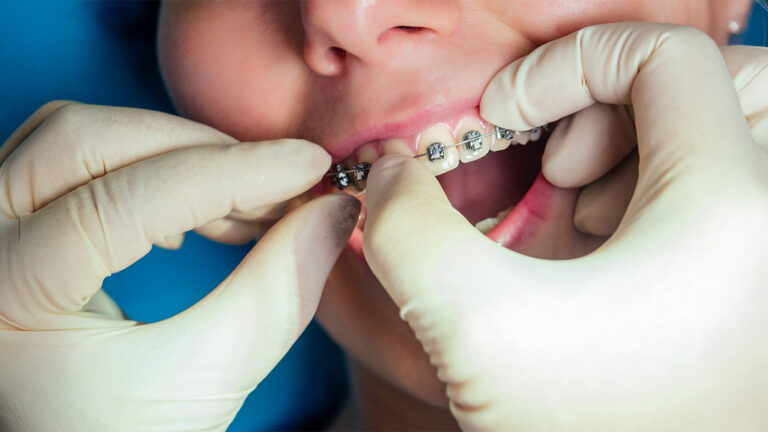In most cases, braces aren’t quite as painful as their reputation suggests. Patients usually get used to their braces fairly quickly and experience very little pain or soreness on a regular basis. The exception is after an adjustment.
Orthodontic work is completed in steps, with the position of the teeth and jaw adjusted a little bit at a time. Each adjustment changes the tension between the wires and brackets, gently moving the teeth a little bit every day throughout treatment.
Because of the increased pressure, teeth may be sore for a few days following an adjustment as the teeth and jaw adjust to the new situation. Your child may need some additional love and care during these periods, and it’s a good idea to offer braces-friendly foods to help ease any pain while eating.
Tips for Eating After an Orthodontic Adjustment
Look for foods that are soft and easy to chew, swallow, and digest. Be wary of hard-to-chew foods like nuts, jerky, granola, chips, popcorn, pretzels, hard candy, and sticky or chewy treats. Tell your child to avoid biting into hard foods that put pressure on the jaw, like apples or corn on the cob. Instead, use a knife to cut their food off the cob or core.
While you’re at it, cut all foods into small bites so the front teeth don’t have to do as much work. Molars (the chewing teeth at the back of the mouth) usually aren’t as sore as the teeth toward the front. Tell your child to place food between the molars and chew slowly and intentionally to avoid biting their tongue or cheeks. Cook hard vegetables like carrots to soften them before serving.
After meals and snacks, remind your child to swish and rinse their mouth to dislodge any food bits stuck between the teeth and the appliance. Maintain good brushing and flossing habits, flossing at least once per day and brushing once in the evening and at least one other time throughout the day.
If your child complains of pain, you can offer over-the-counter pain medications with food. Talk with your pediatrician about age and weight-appropriate doses.
Easy-to-eat Snacks for Kids with Braces
Whether it’s to recharge after a hard day at school or just to hold them over until dinner, kids like to snack between meals, and who can blame them? Unfortunately, tooth and jaw pain following an orthodontic adjustment can ruin snack time. Try these braces-friendly snacks to keep your child smiling.
- Applesauce, yogurt, gelatin, or pudding snacks: Whether homemade or store bought, these smooth and soft treats go down easy and taste good, too! Applesauce and yogurt, in particular, also have nutritional benefits.
- Soft fruits: Not only are fruits like bananas, grapes, mandarin oranges, and berries a healthy snack, they can be eaten without prior preparation. Harder fruits like apples and peaches can be eaten if sliced or cut into smaller pieces.
- Peanut butter: Opt for smooth peanut butter instead of crunchy. It’s delicious, high in protein, and a fan favorite of kids everywhere. Round out your snack by combining peanut butter with sliced fruit or soft bread.
- String cheese: Another childhood favorite, string cheese is soft and full of protein. Pull it apart into small pieces that are easy to eat is part of the fun.
- Popsicles and ice cream: Not only are frozen treats delicious and easy on a sore mouth, but the cold can also reduce swelling and pain during the days after an adjustment. Avoid chewing on ice. While ice can be soothing, it can break brackets or wires.
Easy-to-eat Lunches for Kids with Braces
Adjusting your child’s diet may be necessary, not just after adjustments but throughout their orthodontic treatment. Braces are always vulnerable to physical attacks from hard foods, even if your child’s teeth aren’t sore. Hard or sticky snacks should be eaten sparingly and carefully.
If your child is experiencing soreness after an adjustment, lean on nutritious foods that are easier to chew and swallow.
- Oatmeal: While oatmeal might usually be a breakfast food, it’s nutritionally rich and easy to swallow. Spice it up with berries or other soft fruits.
- Smoothies: All you need is milk or juice as a base and fruit or other mix-ins. Smoothies have the benefit of versatility, with everything from fruit and veggie smoothies to peanut butter and chocolate. They’re a great way to get fruits, vegetables, and proteins without putting your little one’s chompers to work.
- Eggs: While any preparation will do, scrambled eggs are easy to prepare, chew, and digest. They’re packed with protein, and you can spice them up with cooked vegetables, cheese, and other easy-to-chew toppings.
- Mashed potatoes: Boil and mash potatoes with butter, milk, and seasonings. You can also boil and mash carrots, cauliflower, and other vegetables or add cheese for some added flavor and nutrition.
- Rice: Cooked rice is soft, filling, and nutritious. It’s also easy to add to. Mix in some chopped and cooked vegetables and scrambled eggs for an easy-to-eat meal full of flavor and comfort.
- Pasta: Whether it’s spaghetti, mac and cheese, or any other noodle dish, cooked pasta is a familiar soft food most people have on hand. Opt for softer shapes that cook evenly and top with your child’s favorite sauce.
- Soups: A simple tomato soup will do the job, but the possibilities are endless. Try making different soups to add some variety, and if your child’s teeth are especially sore, you can blend vegetable soups to make them easier to swallow.
- Pancakes: This may not be your typical lunch fare, but sometimes eating something is more important than eating the right thing. Pancakes are comforting and easy to eat, so they can be a good option in a pinch.
- Tortillas: Don’t forget to heat them up, they’ll be easier to eat and tastier! You can also use them as the base for a cheese roll-up or quesadilla.
- Liquid lunches: Protein drinks or meal replacement shakes are nutritionally robust and don’t require chewing. You can find them in a variety of flavors, and they can help get some calories and nutrients in your child’s belly when ordinary eating is too difficult.
Every child’s experience of braces will be unique, and some kids breeze through without much pain or discomfort. Pay attention to your child’s behavior and adjust their meal and snack times accordingly. After a few days, kids can usually return to eating most of the foods they typically eat. If you have any questions about specific foods or orthodontic pain, talk with your child’s orthodontist or dentist.




